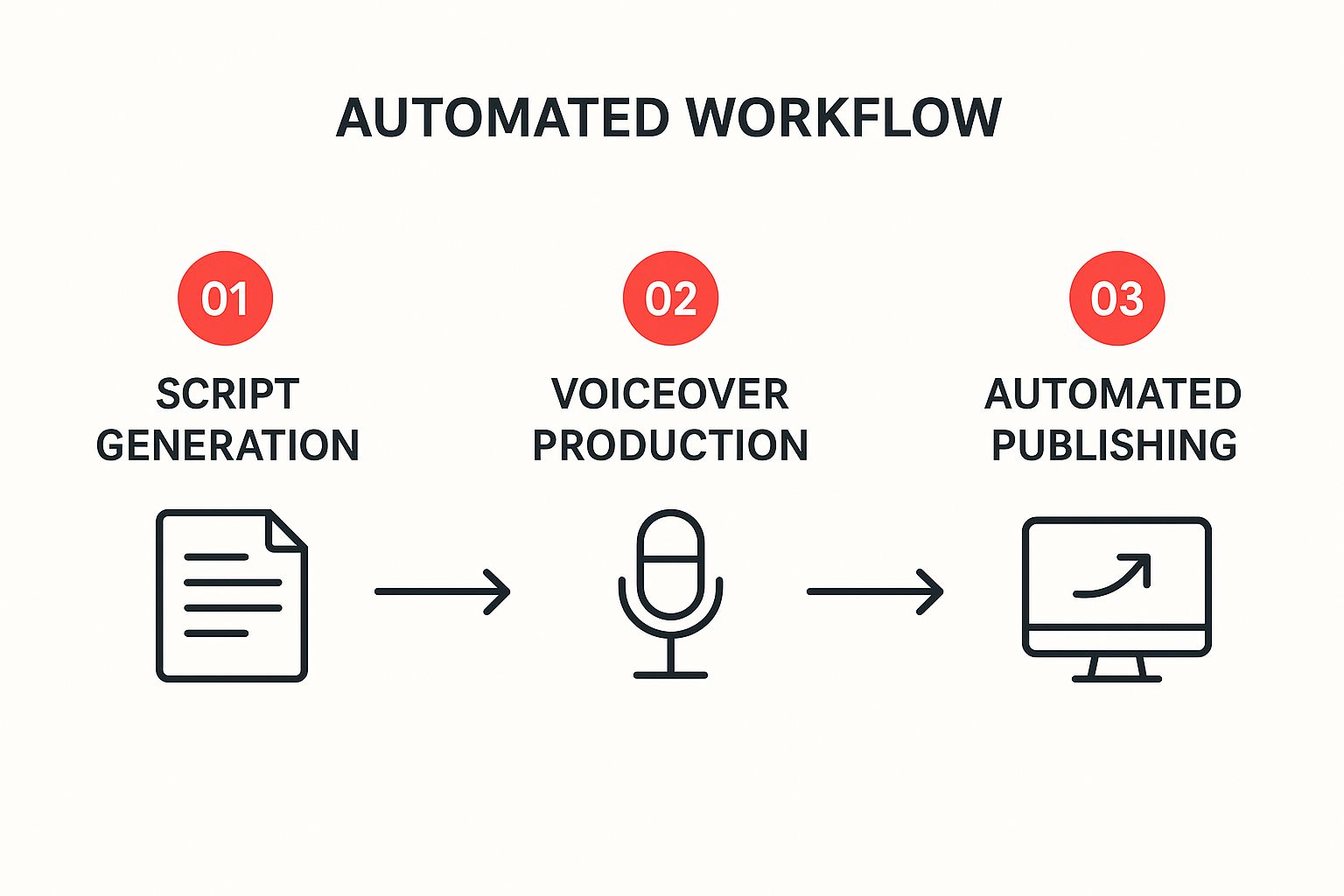So, what's all the buzz around faceless YouTube automation? Put simply, it’s a business model where you create and publish YouTube videos using smart tools and repeatable systems—all without ever showing your face on camera.
This isn't some magic button for instant cash. It’s a strategic approach to building a real media asset. You rely on things like high-quality stock footage, AI-powered voiceovers, and tightly written scripts to produce content that people actually want to watch. The real beauty of this model is its scalability.
What Does "Faceless YouTube Automation" Actually Mean?
At its heart, faceless YouTube automation is about building a well-oiled machine for video creation. You break down the entire workflow—from coming up with an idea to scheduling the final video—into small, manageable tasks.
This systemized approach means you can delegate. You might hire a freelance scriptwriter, use an AI tool for the voiceover, and pass it to an editor. You're not the one-person-band YouTuber; you're the producer, the strategist overseeing a content assembly line. It’s the perfect setup if you want to build a valuable online business without stepping into the limelight.
The Real Story Behind Building an Automated Channel
Let’s be honest: the "automation" part can be a bit misleading. It sounds like you set it up once and watch the money roll in, but the reality is quite different. The initial setup takes a ton of work, and managing the whole system requires your constant attention.
Many people give up way too early because they underestimate the grind and the initial investment needed to get things off the ground. You have to be dedicated and obsessed with quality control. Success comes from constantly checking your analytics, seeing what’s working, and tweaking your strategy.
To get ahead, it's also smart to look at how you can streamline your promotion across different platforms. Using some of the top social media automation tools can be a game-changer for managing your entire online presence more effectively.
The real goal here isn’t just to automate a few tasks. It's to build a content engine that runs on its own, consistently pumping out quality videos that attract a loyal audience. That’s how you achieve long-term growth and, eventually, monetization.
To give you a clearer picture, let's quickly summarize the core building blocks of a successful faceless channel.
Core Components of a Faceless YouTube Channel
| Component | Description | Example Tools |
|---|---|---|
| Niche Selection | Finding a topic with high ad rates (CPM) and a passionate, engaged audience. This is your foundation. | Google Trends, VidIQ |
| Content Production | The step-by-step process of scripting, voiceover, editing, and creating eye-catching thumbnails. | Canva, InVideo, Murf.AI |
| SEO & Optimization | Mastering YouTube's algorithm with smart keyword research, compelling titles, and optimized descriptions. | TubeBuddy, Ahrefs |
| Monetization | Going beyond ad revenue with strategies like affiliate marketing, selling digital products, or sponsorships. | Amazon Associates, ClickBank |
Mastering these components is what separates the channels that thrive from those that fade away.
Your Foundational Pillars for Success
To really make this work, you need to get a few key things right from the very beginning. These are the non-negotiables:
- Picking a Profitable Niche: Don't just follow a trend. You need a niche with high advertiser demand (strong CPMs) and an audience that’s hungry for content.
- Creating a Content Workflow: Develop a repeatable process for scripting, recording voiceovers, editing videos, and designing thumbnails. Consistency is king.
- Learning YouTube SEO: You have to get good at finding the right keywords, writing titles that grab attention, and crafting descriptions that help YouTube understand what your video is about.
- Diversifying Your Income: AdSense is just the start. The most successful channels build multiple income streams through affiliate marketing, their own digital products, or brand sponsorships.
If you're ready to dig deeper and get the full step-by-step breakdown, our guide on how to start a faceless YouTube channel is the perfect place to begin. It walks you through each of these foundational pieces in much more detail.
Finding Your Profitable Faceless Niche
The whole game of faceless YouTube automation is won or lost the moment you pick your niche. This isn't about just choosing something you find mildly interesting. It’s about being strategic. You need to find that sweet spot where real audience demand meets high profitability. That means digging into the data to find topics that pull in viewers and also command high ad rates, what we call CPM (cost per thousand impressions).
Think of your niche like digital real estate. A great location gets more foot traffic and attracts tenants (advertisers) willing to pay top dollar. Niches like personal finance, tech tutorials, and health and wellness are always in demand and tend to have higher CPMs because businesses pay a premium to reach those audiences. On the other hand, a gaming channel might rack up views, but the ad revenue for each one is usually much, much lower.
Analyzing Trends and Audience Demand
Before you go all-in on a niche, you have to be sure people are actually looking for it. A fantastic—and free—tool for this is Google Trends. It shows you how much interest a topic has over time, so you can easily tell a passing fad from a trend with real staying power.
For example, you could compare search interest for "guided meditation" against "ASMR sleep." Right away, you’ll see which one has more consistent, long-term interest. This simple check can save you from building a channel around a topic that's already on its way out.
Here’s a quick look at what that comparison looks like in Google Trends.

This kind of visual data gives you a clear picture of which topics have longevity, helping you make a smart, data-backed decision.
Uncovering High-CPM Sub-Niches
Broad niches like "history" or "finance" are just too crowded. The real secret is to drill down into a specific sub-niche where you can become the go-to expert. Instead of just "history," you could focus on "animated Roman history lessons" or "forgotten Civil War battles." It's much easier to become a big fish in a smaller pond.
Here are a few examples of profitable sub-niches that are perfect for faceless automation:
- Finance: Ditch the generic stock tips. Go for "dividend investing for beginners" or "credit card point optimization strategies."
- Wellness: Instead of broad meditation, try "5-minute morning meditations for anxiety" or "binaural beats for focus."
- Education: Move past basic tutorials. Create content on "Excel tricks for data analysts" or "Python coding projects for intermediates."
These hyper-specific topics attract a dedicated audience that’s actively looking for answers—which is precisely what advertisers want. In fact, well-targeted automated channels can command a 42% higher CPM just by delivering valuable content to a niche audience.
Plus, the YouTube algorithm loves consistency. Channels that post at least three times a week get 2.7 times more recommendations, a goal that's far more achievable when your system is automated. You can learn more about the earning potential by checking out these insights on YouTube automation salaries on shortsgenerator.ai.
Key Takeaway: Don't just pick a niche—validate it. Use real data to find a topic that has proven audience interest, high advertiser value, and enough depth to create content for years. Making this strategic choice is the most important first step in building a profitable automated asset.
Building Your AI Content Assembly Line
This is where the magic of faceless YouTube automation really kicks in. We're not just making a single video; we're building a repeatable, scalable system—an assembly line—that can produce high-quality content while you're barely lifting a finger. Think of yourself as the architect of this system, not the person on the factory floor.
The whole idea is to break the video creation process down into small, manageable chunks. Each piece of the puzzle, from the initial idea to the final edit, can be handed off to a specific AI tool. This is how you start producing content at a volume the YouTube algorithm loves to see.
Generating Endless Video Ideas And Scripts
Every creator knows the feeling of staring at a blank page. For your assembly line, this is actually the easiest part to automate. With just a few well-crafted prompts, AI tools can spit out hundreds of compelling video topics right in your niche.
Once you have a title, you need a script. AI scriptwriters are surprisingly good at this. You can tell them the topic, the vibe you're going for (educational, mysterious, funny), and how long it should be. The AI will then generate a structured script with a clear beginning, middle, and end.
Of course, it won't be perfect right out of the box. Your job is to be the editor—give it a quick read-through, polish the language so it sounds natural, and make sure the story flows. A few minutes of tweaking, and your script is ready for production.
Crafting Voiceovers And Finding Visuals
With a solid script ready, it's time to give it a voice. Forget needing an expensive microphone or a perfect radio voice. Modern text-to-speech (TTS) AI can generate incredibly human-like voiceovers in almost any style or accent you can think of.
Just paste your script into the tool, pick a voice that fits your channel's personality, and download the audio file. This step alone is a game-changer, saving countless hours and removing a huge hurdle for anyone who doesn't like the sound of their own voice.
Next up, you need the visuals. Since you're not on camera, your video will be built from:
- Stock Footage: High-quality video clips that bring your script to life.
- Images and Graphics: Photos, illustrations, or charts to help explain key points.
- Background Music: Royalty-free tunes to set the mood and keep people watching.
Platforms like Envato Elements or Storyblocks are perfect for this. For a simple monthly fee, you get access to massive libraries of all these assets.
This image shows how all the pieces fit together in a smooth workflow.

As you can see, each automated step flows directly into the next, creating a non-stop content machine from idea to final upload.
Assembling The Final Video
The last stop on our assembly line is video editing. This is where you bring the voiceover, stock footage, images, and music together into a finished video. Even this part is getting easier. Editors like InVideo and Descript have AI features that can automatically sync your visuals to the words in your script, saving a ton of tedious work.
The secret to success with a faceless channel isn't about becoming a video editing wizard. It's about building a system so efficient that you can consistently publish great content without burning yourself out.
The quality of your content pipeline really comes down to choosing the right tools. Your success hinges on the best AI tools for content creation you decide to plug into your workflow. With 2.7 billion users on YouTube every month and 500 hours of video uploaded every minute, you need that edge to stand out.
I've put together a quick table to help you visualize a potential tool stack.
AI Tool Stack for Faceless Content Creation
Here’s a look at some popular AI tools that can handle different parts of your video production. This should give you an idea of how to build a stack that fits your budget and needs.
| Task | Recommended AI Tool | Key Feature |
|---|---|---|
| Idea Generation | TubeBuddy | Topic Explorer suggests high-demand, low-competition keywords. |
| Scriptwriting | Jasper AI | "Video Script Outline" template creates structured narratives quickly. |
| Voiceover | Murf.ai | Offers a wide range of natural-sounding voices and emotional tones. |
| Video Editing | InVideo | AI Text-to-Video feature automatically finds visuals for your script. |
| Thumbnail Design | Canva | "Magic Design" generates thumbnail options from just a text prompt. |
Mixing and matching tools like these allows you to create a completely customized and highly efficient workflow.
Ultimately, your assembly line should do the heavy lifting for you. This frees you up to focus on the bigger picture: strategy, growth, and figuring out what your audience wants next. A huge part of that is having a strong channel identity. For some tips on that, check out our guide on how to create a faceless YouTube channel description that actually converts.
Making Sure Your Videos Actually Get Seen
Look, you can create the most amazing video in the world, but if nobody sees it, what's the point? All that effort you put into your content assembly line is wasted. This is where the real work of a successful faceless YouTube automation channel begins: getting your content in front of the right eyeballs.
It all starts with figuring out what your audience is actually typing into the YouTube search bar. This isn't a guessing game. It’s about using data to find the exact phrases and questions people are looking for answers to. For this, tools like VidIQ or TubeBuddy are absolute game-changers.
Winning at YouTube SEO
You have to remember that YouTube is basically a giant search engine—the second largest on the planet, in fact. To get your videos noticed, you need to speak its language. That means optimizing every single part of your upload to tell the YouTube algorithm exactly what your video is about and who should see it.
Your title is your first shot at grabbing someone's attention. It has to be compelling, but it also needs to be loaded with the keywords you're trying to rank for. For example, a lazy title like "Meditation Video" is going to get buried. A much stronger, SEO-driven title would be something like, "10-Minute Guided Meditation for Anxiety and Stress Relief." See the difference?
Here's a peek at the kind of data VidIQ can give you to help shape your titles and overall content strategy.

This shot shows you the goldmine of information you get—search volume versus competition. It helps you zero in on keywords that give you a fighting chance to actually rank and get views.
Next up is your thumbnail. Think about it: when you're scrolling through YouTube, what makes you click? It's the thumbnail. Use bright colors, easy-to-read text, and a compelling image that sparks a little curiosity. A killer thumbnail paired with a great title is the one-two punch you need for a high click-through rate (CTR).
And don't sleep on the video description. It's more than just an afterthought; it's prime real estate for SEO.
- Front-load the good stuff: The first two or three lines are critical. Put your main keyword there and tell people exactly what they'll get from watching.
- Weave in more keywords: Sprinkle in some related, long-tail keywords naturally. Don't just stuff them in; make it readable.
- Add timestamps: Break your video into chapters. This is great for viewers and gives YouTube even more context about what's inside your video.
A quick word on tags: while they aren't as powerful as they used to be, they still matter. Add relevant tags to help YouTube categorize your video and show it next to similar content. It's an easy win that can get you more exposure in the "suggested videos" sidebar.
Putting Your Publishing on Autopilot
Consistency is king on YouTube. The algorithm loves channels that post on a regular, predictable schedule. This is where the "automation" part of your strategy really shines.
Instead of being chained to your desk, manually uploading every video, you can batch everything. Spend a weekend creating content, then use YouTube’s own scheduler to line up your videos for the next few weeks or even a month.
This creates a steady, reliable flow of content that goes live without you having to lift a finger. It's the ultimate "set it and forget it" workflow.
Monetizing and Scaling Your Channel

Alright, your content assembly line is up and running, and the views are finally starting to climb. Now for the fun part: turning those eyeballs into actual income.
Let me be clear: YouTube ads are a fantastic starting point, but the truly successful faceless YouTube automation channels don't stop there. They build multiple, resilient income streams. Relying only on AdSense is like building a house on a single pillar—one little algorithm shift can knock you over. A diversified strategy is your best insurance policy.
The goal here isn't just to have a channel; it's to build a real business. That means thinking way beyond the view count and creating a genuine financial asset.
Beyond YouTube Ads
Of course, the first big milestone is getting into the YouTube Partner Program. But honestly, that’s just the first rung on the monetization ladder. If you need a refresher on the specifics, we've got a detailed guide covering all the official YouTube monetization requirements.
Once you’ve hit that mark, it’s time to get serious. Here are the revenue streams that work incredibly well for faceless channels:
- Affiliate Marketing: This is often the biggest money-maker. All you do is recommend products or services that fit your niche and you get a commission for every sale that comes through your link. A finance channel might promote budgeting software, while a meditation channel could link to high-quality headphones. It's a natural fit.
- Digital Products: This is where you really take control. You can create your own assets—think ebooks, digital planners, or short guides. For example, a channel that creates animated history videos could sell a beautifully designed digital timeline poster. The best part? You keep 100% of the profit and build a much stronger connection with your audience.
Key Insight: The most successful faceless channels don't just entertain; they solve a problem. Your digital products and affiliate recommendations should be direct solutions to the challenges your audience faces.
Attracting Brands and Building Community
Think you can't get brand sponsorships without showing your face? Think again. Brands don’t care about seeing you; they care about reaching your audience. Your channel's analytics are all the proof they need.
A niche channel with 50,000 highly engaged subscribers is often far more valuable to a brand than a generic channel with a million passive viewers.
To make your channel a magnet for brands, focus on building a real community. This is what turns casual viewers into loyal fans. It’s a powerful way to scale your channel’s influence and income for the long haul. Learning How to Build an Online Community That Thrives is a skill that pays dividends far beyond direct monetization.
Using Analytics to Scale Smartly
As you grow, your decisions need to be driven by data, not guesswork. Spend time in your YouTube Analytics. Figure out which videos are bringing in the most subscribers, which ones have the highest watch time, and which ones are making you the most money.
Look for patterns. Is there a specific sub-topic that always seems to pop off? That's the signal from your audience to double down. Use this data to constantly refine your content strategy, make your workflow more efficient, and maximize your profits.
Common Questions About YouTube Automation
Jumping into the world of faceless YouTube automation is exciting, but it’s totally normal to have a bunch of questions swirling around. Let’s tackle some of the biggest uncertainties people have before they get started.
One of the first things on everyone's mind is money. Do you need a massive war chest just to get in the game?
How Much Does It Cost to Start?
Honestly, your initial investment can be surprisingly lean. It’s entirely possible to get a channel up and running for around $100 to $200. This covers the basics—a simple video editor, an AI voiceover tool, and a solid thumbnail designer to make your videos click-worthy.
Now, if you plan on outsourcing everything from the get-go, that's a different story. To have freelancers handle your scriptwriting and video editing, you’re looking at a budget closer to $500-$1000 per month. My advice? Start small. Reinvest what you make in the beginning and only scale up your spending once the channel starts proving itself.
Is This Business Model Actually Profitable?
Yes, absolutely. There's a common myth that you have to be the star of the show to make serious money on YouTube, and it's just not true. Some of the platform's biggest earners are completely faceless.
Your potential for profit really boils down to three things:
- A smart niche choice where advertisers are willing to pay top dollar (high CPMs).
- Content that's actually good and keeps people watching.
- Multiple income streams beyond just the ads YouTube places on your videos.
When you mix AdSense revenue with affiliate marketing, selling your own digital products, or even landing sponsorships, a faceless channel can turn into an incredibly profitable business.
The key isn't the absence of a face; it's the presence of value. As long as your videos solve a problem, educate, or entertain, you have the foundation for a successful business.
How Long Until I See Real Results?
This is where you need to be patient. I can't stress this enough. You're not going to go viral overnight. For most new channels, you're looking at a solid 6 to 12 months of consistent work—that means uploading at least one to three videos every single week—to hit YouTube's monetization goals.
Those goals are getting 1,000 subscribers and 4,000 hours of watch time. Some channels get there faster, and for others, it takes a bit longer. How quickly you grow really depends on your niche, the quality of your content, and how well you optimize your videos so people can actually find them.
Ready to skip the long wait for monetization? MonetizedProfiles offers monetization-approved YouTube accounts, allowing you to start earning revenue from day one. Get your fully eligible channel and fast-track your faceless automation journey.









